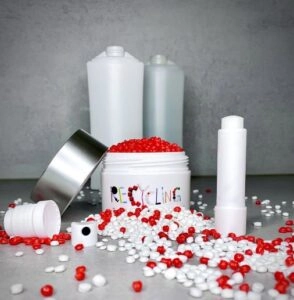What is meant by bio-plastics?
The term bioplastic describes both plastic on a biological basis and biodegradable plastics.
- How much organic is in organic plastics? Biopolymers, is a plastic that consists wholly or partly of the following substances:
from renewable raw materials such as sugar cane or other starch-based raw materials - it is completely or partially biodegradable
Bio-based, what does it mean?
In the case of plastics made from sugar cane or similar raw materials, the granules are made entirely or partially from biomass. The various bio-based components include raw materials made from starch and/or cellulose. The most commonly used raw materials from these groups for the production of bio-based plastics are corn starch and sugar cane. However, it is also possible to obtain cellulose from different types of wood in order to be able to use these components for the production of other bio-plastics (WPC / NFC). Furthermore, there can be raw materials for the production of biopolymers based on chitin, lignin, casein, gelatine and vegetable oil, which, depending on the composition and the admixture of various additives, have a significant impact on improving product properties such as formability, hardness, elasticity and breaking strength , heat resistance and resistance to chemical substances.
When is a plastic considered biodegradable?
The biodegradability of a plastic is achieved by going through a process, mostly on a chemical basis, in which different organisms break down the material into components such as e.g. converts water and CO². This process can vary depending on the type of plastic and its special composition, its duration and the extent of the chemical additives used.
In which areas are bioplastics used?
The category of biodegradable plastics is primarily used where there is a close combination of plastics and natural raw materials, with the aim of not endangering or polluting nature. A good example of this includes tarpaulins for agricultural operations. However, these polymers can also be used for packaging materials in the food, cosmetics and toy industries because they can be classified as harmless by various standards and tests.
In the medical and pharmaceutical sector, the focus of product development for bioplastics is mainly on the absorbability of the product. Sutures, screws, adhesives or implants must be broken down after use and absorbed by the body to avoid further surgery or intervention. Therefore, particularly high-quality bioplastics and biodegradable plastics are used here. Accordingly, PLA and its copolymers and degradable polycaprolactone are processed into sutures and surgical screws, nails and plates. In addition to gelatine, water-sensitive and quickly dissolving thermoplastic starch is also used as capsule material for pharmaceuticals. Materials with different resorption times can be used for implants and are used according to their application. c) The use of bio-based materials is limited on the one hand by the available quantity and on the other hand by the available quality. For example, they are attached to vehicle structures using the sandwich method. The core of the component consists of a bio-based polymer covered with layers of conventional materials of higher quality (optical, haptic, wear-resistant or functionalized). criticism and market conditions.
Bioplastics currently account for only a few percent of global plastics production. Bioplastics are often criticized because no material flow for recycling has been established so far. Food suitability is also viewed critically. Bioplastics cannot be recycled (mechanically utilized) without a specific recycling process (material flow). The recycling of bioplastics is therefore still a challenge, especially since biodegradable plastics have to remain in the composting facility longer than waste such as biodegradable plastics. Plastics made from bio-based raw materials are not necessarily more environmentally or climate-friendly than fossil-based plastics. While traditional plastics typically produce more greenhouse gases, some of the renewable resources in bioplastics are grown on farmland. This allows cultivation to compete with the food supply. Perspective: EU law
The European Commission has set itself the goal of clarifying the bioplastics debate. As part of the implementation of the European action plan for the circular economy, it must be clearly regulated which plastics are considered „compostable“ or „biodegradable“ and how they are to be disposed of. In addition, the committee wants to clearly define terms like “bio-based”, “biodegradable” and develop a life cycle analysis to determine which types of bioplastics are beneficial.



